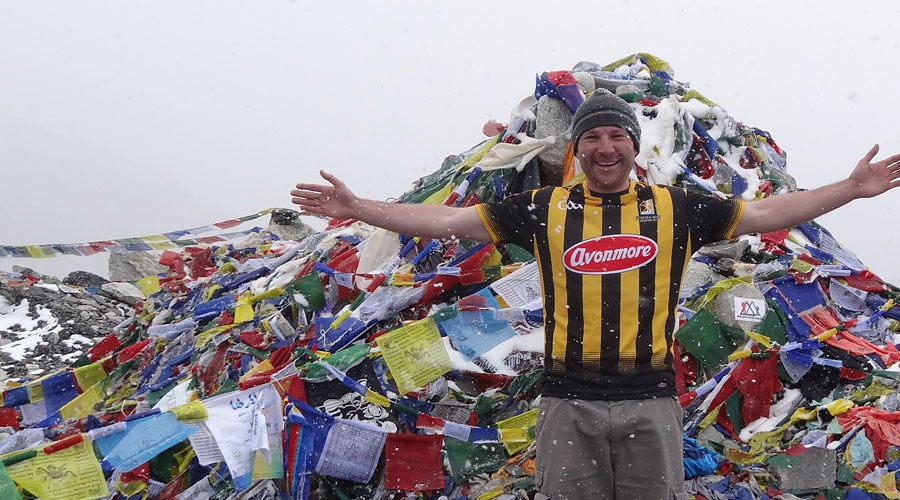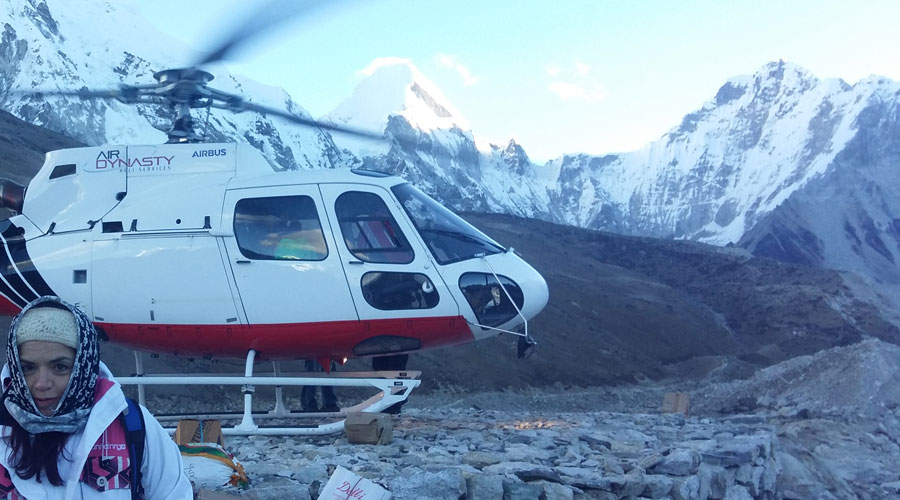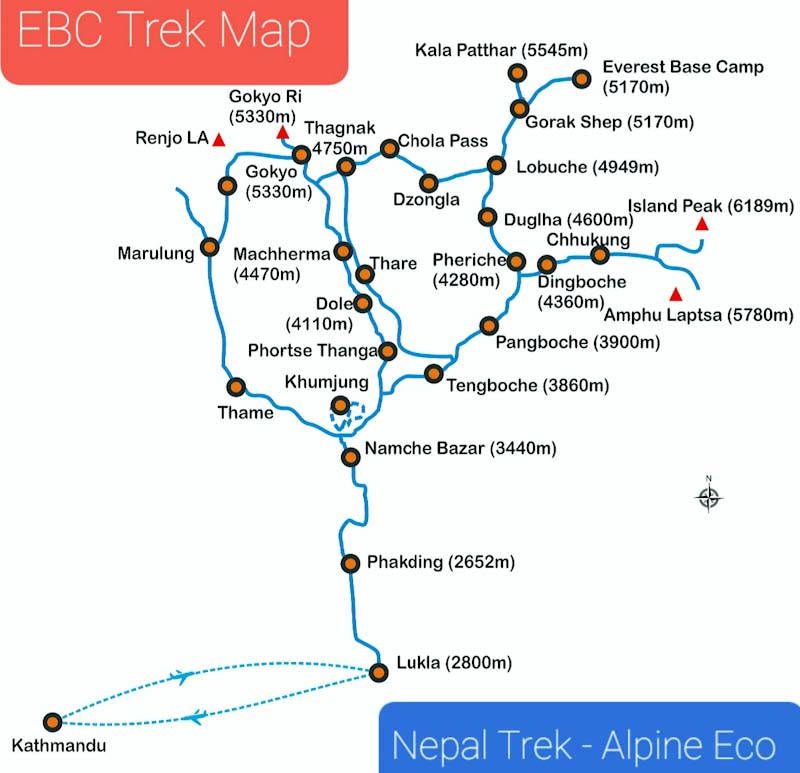7 days Everest Base Camp trek with Helicopter return is a combination of trekking and helicopter tour in the Everest region.
Once you land in Kathmandu, our airport representative will greets you. Your trekking guide, who will come to pick you up will drop you off at the hotel we booked for you on our private tourist vehicle. There will be a pre-trek meeting where you will be briefed about the trip and other details. Next day ride into a small plane to the famed Lukla Airport with your trekking guide, the gateway to Everest, and start trekking. During the trek, you will see the natural world heritage site i.e Sagarmatha National Park. Alongside, you will explore the world-famous adventure place on earth, Everest Base Camp.
Overall 7 days Everest Base Camp trek with Helicopter return at lowest cost is sure to feed your soul and will give you a lifetime experience of a Helicopter flight over the Himalayas on the way back.
7 days Everest base camp trek is especially designed for those who have very short time and want to trek quickly to Everest Base Camp. This trek might not be perfect for all but it definitely for those who are physically fit and have experience of hiking and have a very short period of time to trek to Everest base camp.
During 7 days Everest base camp, you can see all highest peaks and mountains of the Everest region like Lobuche east, Lobuche west, Khubtse, Nuptse, Lhotse, Everest, Pumori, Amadublum and many more from its closest point. After achieving the destination we will trek back to Gorakshep and fly back to Kathmandu.
7 Days Everest Base Camp Trek with Helicopter Return


- Detailed Itinerary
- Dates & Cost
- FAQ
- Gallery
- Trip Info
- Check List
Detailed Itinerary
Trip Itinerary
| Day | Highlights |
|---|---|
| Day 01 |
Arrive in Kathmandu: |
| Day 02 |
Fly from Kathmandu to Lukla and Trek to Namche Bazaar: |
| Day 03 |
Trek from Namche Bazaar to Tengboche: |
| Day 04 |
Trek from Tengboche to Dingboche: |
| Day 05 |
Trek from Dingboche to Lobuche: |
| Day 06 |
Trek to Everest Base Camp and Trek to Gorak Shep: |
| Day 07 |
Early Morning Hike to Kala Patthar and Helicopter flight to Kathmandu: |
Note: If above itinerary couldn’t meet your needs, we can design a tailor-made itinerary to suit your needs. This is group trek adventure, and one of the best and cheapest options in Everest region.
Departure Dates & Cost
Trip Dates & Price
| Start Date | End Date | Cost | Status | Booking |
|---|---|---|---|---|
| 20 Feb 2024 | 26 Feb 2024 | US$ Contact us | available | Book Now |
| 05 March 2024 | 11 March 2024 | US$ Contact us | available | Book Now |
| 15 March 2024 | 21 March 2024 | US$ Contact us | available | Book Now |
| 25 March 2024 | 01 April 2024 | US$ Contact us | available | Book Now |
| 10 April 2024 | 16 April 2024 | US$ Contact us | available | Book Now |
| 25 April 2024 | 01 May 2024 | US$ Contact us | available | Book Now |
| 15 May 2024 | 21 May 2024 | US$ Contact us | available | Book Now |
| 10 June 2024 | 16 June 2024 | US$ Contact us | available | Book Now |
| 15 July 2024 | 21 July 2024 | US$ Contact us | available | Book Now |
| 20 Aug 2024 | 26 Aug 2024 | US$ Contact us | available | Book Now |
| 05 September 2024 | 11 September 2024 | US$ Contact us | available | Book Now |
| 20 September 2024 | 26 September 2024 | US$ Contact us | available | Book Now |
| 30 September 2024 | 06 October 2024 | US$ Contact us | available | Book Now |
| 12 October 2024 | 18 October 2024 | US$ Contact us | available | Book Now |
| 25 October 2024 | 31 October 2024 | US$ Contact us | available | Book Now |
| 01 November 2024 | 07 November 2024 | US$ Contact us | available | Book Now |
| 10 November 2024 | 16 November 2024 | US$ Contact us | available | Book Now |
| 25 November 2024 | 25 November 2024 | US$ Contact us | available | Book Now |
| 01 December 2024 | 07 December 2024 | US$ Contact us | available | Book Now |
| 10 December 2024 | 16 December 2024 | US$ Contact us | available | Book Now |
| 20 December 2024 | 20 December 2024 | US$ Contact us | available | Book Now |
| 30 December 2024 | 05 Jan 2025 | US$ Contact us | available | Book Now |
Cost Includes
- Hotel in Kathmandu
- The entire airport picks up and drops
- Necessary flights from Kathmandu to Lukla return trips.
- Airfare for trekking crew
- Necessary equipment such as (Sleeping bag, duffle bag) during the trek
- Accommodation in guesthouse and local lodge during the trekking days with breakfast
- Tims card (trekking information management system card)
- English speaking guide and strong porters (2 clients = 1 porter)
- Food, clothing, salary and thier insurance
- Helicopter tour from Kalapattar to Kathmandu
- All necessary grounded transportation
- Arrangement of Emergency Helicopter service which will be paid by your Travel insurance company.
- Our service charges with VAT and Local / Government Taxes.
Cost Excludes
- Lunch and dinner in trekking days (Meal (each item cost about $5 - $8 dollar (depending on the place where you eat and what you eat)
- Lukla trekking entrance fees NRs 2000, Sagarmatha national park fee
- Sightseeing or any extra activities except the above program
- Personal nature expenses
- Personal equipment and clothing
- Any bottled drink such as coke, Fanta, beer, wine, mineral waters, etc
- Internet/wifi, hot shower, phone calls and laundry services
- Your travel insurance and tips for guide and porters.
Trip FAQ
Trip FAQ
7 days Everest Base Camp trek Helicopter return is suitable for average people who are physically active. You can, however, take some physical fitness training such as running, swimming and hiking before you embark on this journey. While on the trek, it is common to experience some discomfort before being fully acclimatized. Two rules you need to remember to prevent and beat AMS ( Altitude mountain sickness) are: you need to drink lots of water and walk slow.
Along the trekking routes, you will be accommodated at the best luxury lodges which provide finest facilities in the mountains. We can also provide you Alpine Eco Tour sleeping bags on rent if needed but it is a good idea to always have your own sleeping equipment. The lodges in trekking routes usually provide single and double rooms. At times when possible, dining will be around a bon fire.
The luxury lodges cook a delicious range of mostly vegetarian fare. Pasta, tuna bakes, noodles, potatoes, eggs, daal bhat (rice and lentils), bread, soup, fresh vegetables (variety depends on the season) and even some desserts like apple pies, pancakes, and some interesting attempts at custard. You will find a lot of garlic on the menu because it assists with acclimatization – eat some every day. In many larger villages you may find some meat items on the menu. You can always get hot chocolate, tea, and hot lemon drinks, as well as soft drinks, and treats like chocolate and crisps. Each day dinner and breakfast will be at a lodge you’ll stay at while lunch will be taken on the way to destination.
The primary modes of air transport in mountain region are Twin Otter and Dornier. Sometimes, due to bad weather conditions or other technical issues, flights may get cancelled or delayed to Lukla. In this case, we can rebook your flight for the next day. We highly recommend you to prepare ahead for unforeseen circumstances (flight delay, bad weather) and schedule a couple of extra days for the trek. Other possible option is to charter a private full-reserved helicopter to ensure you don’t miss deadline for the trek or your international flight. The helicopter takes 5 passengers at a time, and the cost of trekking guide should be shared by trekkers respectively. The private helicopter charter between Kathmandu and Lukla will cost you extra USD 2,500 to reserve a private helicopter in addition to the domestic flight airfare. If you want to take a helicopter on a sharing basis, it will cost you USD 500 per person. This price is applicable during emergencies or when you have given us a notice in less than 24 hours. We will try to find a cheaper option but the average rate for quick arrangement of helicopter is USD 500 per person. Please note that when you request for a helicopter in a short time (i.e. less than 24 hours) for any reason except emergencies, you will have to be in queue to use the helicopter flight. There are a limited number of helicopters and they are used in a wide range of activities in the mountains. So, please keep in mind you won’t be able to fly at your requested time quickly if you book late. The earlier you book, the earlier and on time you can use the helicopter.
The helicopter flight from Kalapatthar to Kathmandu is on a sharing basis. You will share it with other members of your own group or with trekkers from other companies. The helicopter can carry 5 passengers excluding the pilot. It will fly over Everest Base Camp/Kalapatthar and drop you off at Kathmandu. The helicopter ride takes about 2 to 3 hours depending on the weather and the number of passengers with stops at Namche and Lukla. If you prefer a private helicopter flight with landing, please contact us to find out the additional cost.
The months from March to May and from late September to early December are the best time to sign up for this trip.
Every trekking trip up the mighty Mt. Everest presents its own amazing, unforgettable moments that forever live on in the hearts and minds of those brave enough to make the climb. One of the most unpredictable elements of the Everest region is the weather. If you’re not properly prepared for the twists, turns and volatility of the conditions that can occur in this breathtaking region, you might find yourself in an uncomfortable and unpleasant situation. Here are some weather basics to help ensure that you come to the Himalayas as well equipped and prepared to face anything. Generally speaking, the nights are much cooler than the daytime hours in the Everest region. Many first-time trekkers are surprised to learn about the incredible range that may occur in a given day. During the day, the thermometer could reach temps as high as 25 degrees C, only to dip down as low as -5 degrees C in less than 24 hours. While there’s no way to know exactly what each day in the mountains will bring, the weather and temperature ranges tend to be somewhat predictable based on the month and season. Spring – March / April / May / June: Spring happens to be one of the best times of the year to visit the Everest region, although because of this, it can become somewhat crowded. One can meet many other Everest climbers during this season and base camp is full of tents. The beautiful clear blue sky can be seen and the many different species of flower are visible in the lower altitude. During springtime, the average temperature is 15 degrees C with a maximum of 20 degrees C during sunny days and a minimum of 5 degrees C in the morning and at night for areas above 3000 meters. July / August Through Mid-September is Monsoon Season This season is not really recommended to travel as it rains in the lower altitudes, below 3000 meters. In areas above 3000 meters, sometimes it rains and most of the time its dry, very few people travel during this season. There are positives to trekking during the monsoon months, however. The excess rainfall can provide ample chance to see spectacular views of the waterfall and it’s also the best season to avoid the crowds. The maximum temperature during the monsoon season averages 20 degrees C during sunny days with a minimum 8 degrees C in the morning and night at areas above 3000 meters. The average temperature tends to hover around a comfortable 14 degrees C. Autumn – End of September / October / November Similar to springtime, autumn in the Everest region is also a crowded season, but it’s one of the best times to trek. While it lacks the beauty of flowers, the clear blue sky can be seen, affording incredible views from just about every angle. The average temperature during the fall is 15 degrees C with a maximum temp of 20 degrees C during sunny days and a minimum of -2 degrees C in the morning and at night, for areas above 3000 meters altitude. Regardless of time of year, trekkers should always plan accordingly and bring clothing for both cooler and warmer temps. Layering is always recommended, as are pants that can double as shorts. For a full list of clothing and materials to bring to account for various temperatures and weather changes that can occur in the Everest region, visitors should work closely with their travel provider. This will ensure that the adventure will be enjoyable no matter what the weather and that every possible scenario will be accounted for ahead of time.
There are telephones in some villages along the trekking routes from which you can make international calls. All our guides are equipped with the local mobile phone. You may wish to pass the number of our guide to your family for the call-back or you can make a call from the guide’s mobile and pay him directly for the international call too.
In the most parts of Kathmandu, you can use your credit cards. But, on the trek, all you need is cash. Please change the currency in local Nepali Rupees before you go to the mountains.
It depends on your spending habits. Generally, in Kathmandu, you can allocate USD 10 to USD 15 for a lunch and a dinner. USD 10 to USD 15 per person a day will be enough to buy bottles of water, chocolates, pay for the hot shower and a few drinks during the trekking.
This is a difficult thing to gauge. We have seen everything from USD 20 to USD 1000 per person for guides and porters. Tipping is not mandatory, but it is a small gesture of thanks to your guides and local porters. The level of the tip should reflect the level of satisfaction from and personal involvement with your guide. However, we recommend you to spend minimum 10% of your total trip cost for tipping entire local staffs, the ratio of tipping guide and porter will be given to you at the pre-trip meeting in Kathmandu before starting the trek.
Yes, they have all received 45-day training from the Hotel Management and Tourism Center in Nepal. The guides have also received high-altitude first-aid training from KEEP (Kathmandu Environmental Education Project).
Bottled water is easily available at the lodges and teahouses. A bottle costs from USD 1 at lower elevations to USD 4 at higher elevations. We don’t advise you to drink from trail side tap or spring water.
Our guides are 24 hours available for the services during the trek. They are trained to use first aid kit and have knowledge to use Oxy meter. They are very much aware that higher the altitude the oxygen level gets lesser so to get updated on the oxygen level of our client and to know whether they are fit enough or needs extra precautions to continue. Guides carry local sim cards both Nepal Telecom and Ncell in order to update whereabouts and situation of our every client. During the time of emergency our guides are alert and keeps updated to head office in Kathmandu that is available 24 /7 to arranging from horse to mules or helicopters in the must needed cases especially when client is seriously sick in the mountain and needed to be hospitalized.
For Lukla flights you are given only 15kgs as weight limit, which is equal to 33 Pounds; this includes both your duffel bag and daypack. So please pack and prepare wisely. If you exceed your limit additional cost of USD 2 to USD 5 Per Kgs would be applicable in the airport and this amount should be paid at the airport in airlines counter itself.
The Covid-19 vaccinations are compulsory in Nepal, we also recommend you are covered for diphtheria and TB, hepatitis A, hepatitis B, malaria, typhoid, polio and tetanus. We also recommend: • A dental check-up prior to travelling • That you know your blood group in case of emergency If you have any pre-existing medical conditions which might affect you on tour, you make these known to your trek leader and Alpine Eco Trek at the time of your booking.
Ask your question.

